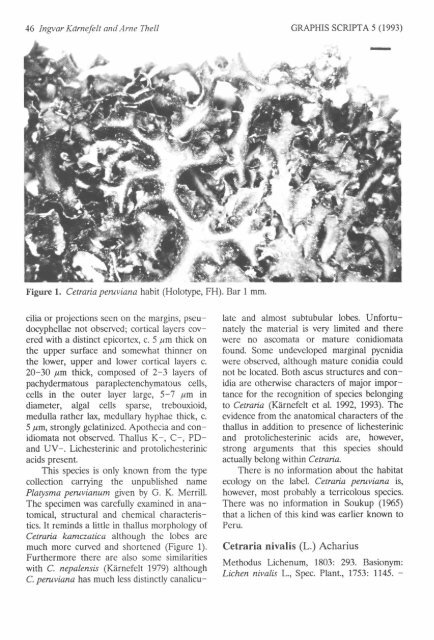CRAPHIS ScnIPTA - Universitetet i Oslo
CRAPHIS ScnIPTA - Universitetet i Oslo
CRAPHIS ScnIPTA - Universitetet i Oslo
You also want an ePaper? Increase the reach of your titles
YUMPU automatically turns print PDFs into web optimized ePapers that Google loves.
46 Ingvar Kcirnefelt and Arne Thell<br />
W<br />
Figure 1. Cetraia peruviana habit (Holotype, FH). Bar L mm.<br />
cilia or projections seen on the margins, pSeudocyphellae<br />
not observed; cortical layers covered<br />
with a distinct epicortex, c. 5 pm thick on<br />
the upper surface and somewhat thinner on<br />
the lower, upper and lower cortical layers c.<br />
20-30 pm thick, composed of 2-3 layers of<br />
pachydermatous paraplectenchymatous cells,<br />
cells in the outer layer large, 5-7 pm in<br />
diameter, algal cells sparse, treborxioid,<br />
medulla rather lar, medullary hyphae thick, c.<br />
5 pm, strongly gelatinized. Apothecia and conidiomata<br />
not observed. Thallus K-, C-, PDand<br />
UV-. Lichesterinic and protolichesterinic<br />
acids present.<br />
This species is only known from the type<br />
collection carrying the unpublished name<br />
Platysma peruvianum given by G. K. Merrill.<br />
The specimen was carefully examined in anatomical,<br />
structural and chemical characteristics.<br />
It reminds a little in thallus morphology of<br />
Cetraria kamczatica although the lobes are<br />
much more curved and shortened (Figure 1).<br />
Furthermore there are also some similarities<br />
with C. nepalensis (Kiirnefelt 1979) although<br />
C. peruviana has much less distinctly canalicu-<br />
GRAPHTS SCRIPTA 5 (1e93)<br />
late and almost subtubular lobes. Unfortunately<br />
the material is very limited and there<br />
were no ascomata or mature conidiomata<br />
found. Some undeveloped marginal pycnidia<br />
were observed, although mature conidia could<br />
not be located. Both ascus structures and conidia<br />
are othenvise characters of major importance<br />
for the recognition of species belonging<br />
to Cetraia (Kiirnefelt et al. 1992, 1993). The<br />
evidence from the anatomical characters of the<br />
thallus in addition to presence of lichesterinic<br />
and protolichesterinic acids are, however,<br />
strong arguments that this species should<br />
actually belong within Cetraria.<br />
There is no information about the habitat<br />
ecology on the label. Cetraia peruviana is,<br />
however, most probably a terricolous species.<br />
There was no information in Soukup (1%5)<br />
that a lichen of this kind was earlier known to<br />
Peru.<br />
Cetraria nivalis (L.) Acharius<br />
Methodus Lichenum, 1803: 293. Basionym:<br />
Lichen nivalb L., Spec. Plant., L753: LL45.

















